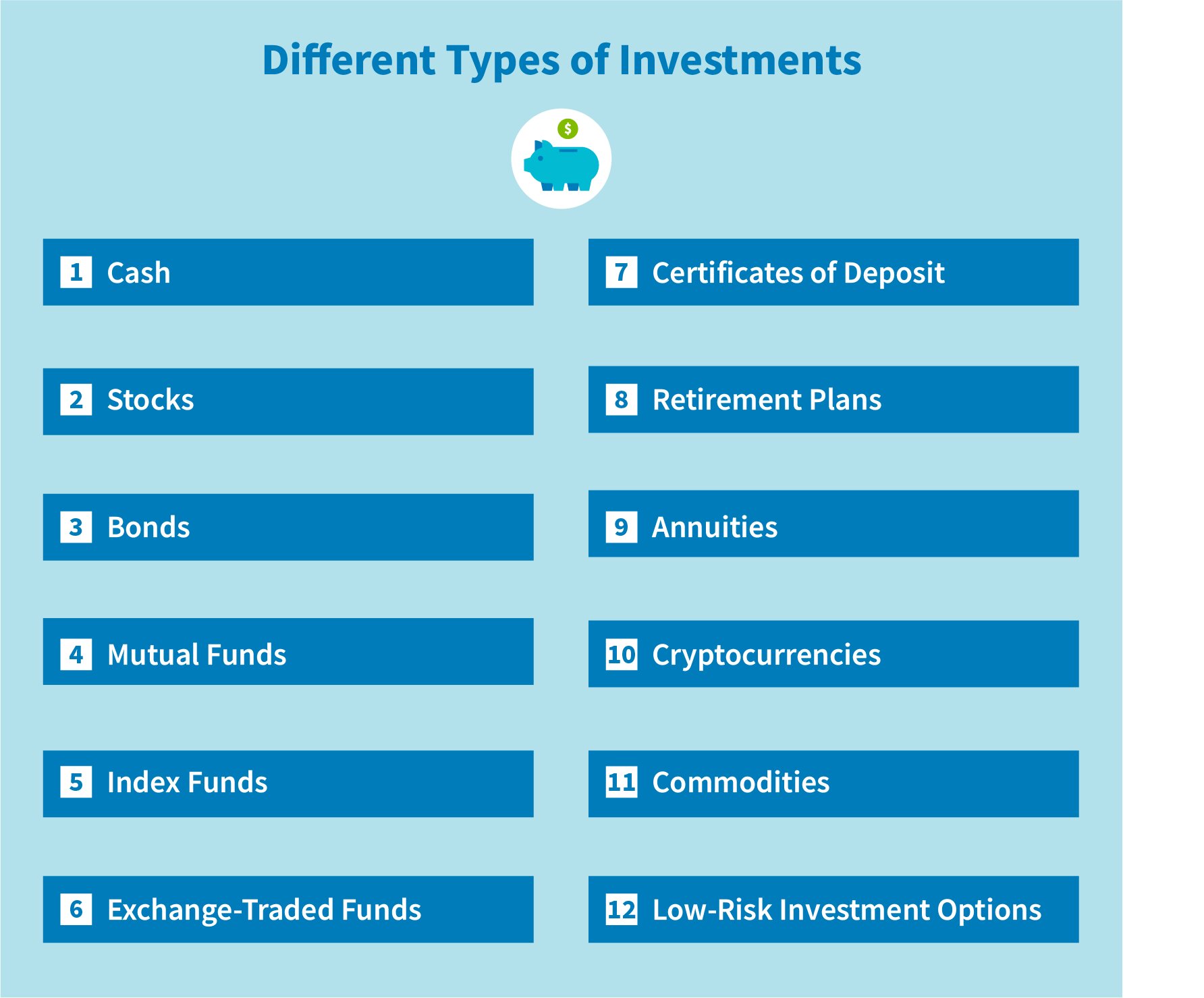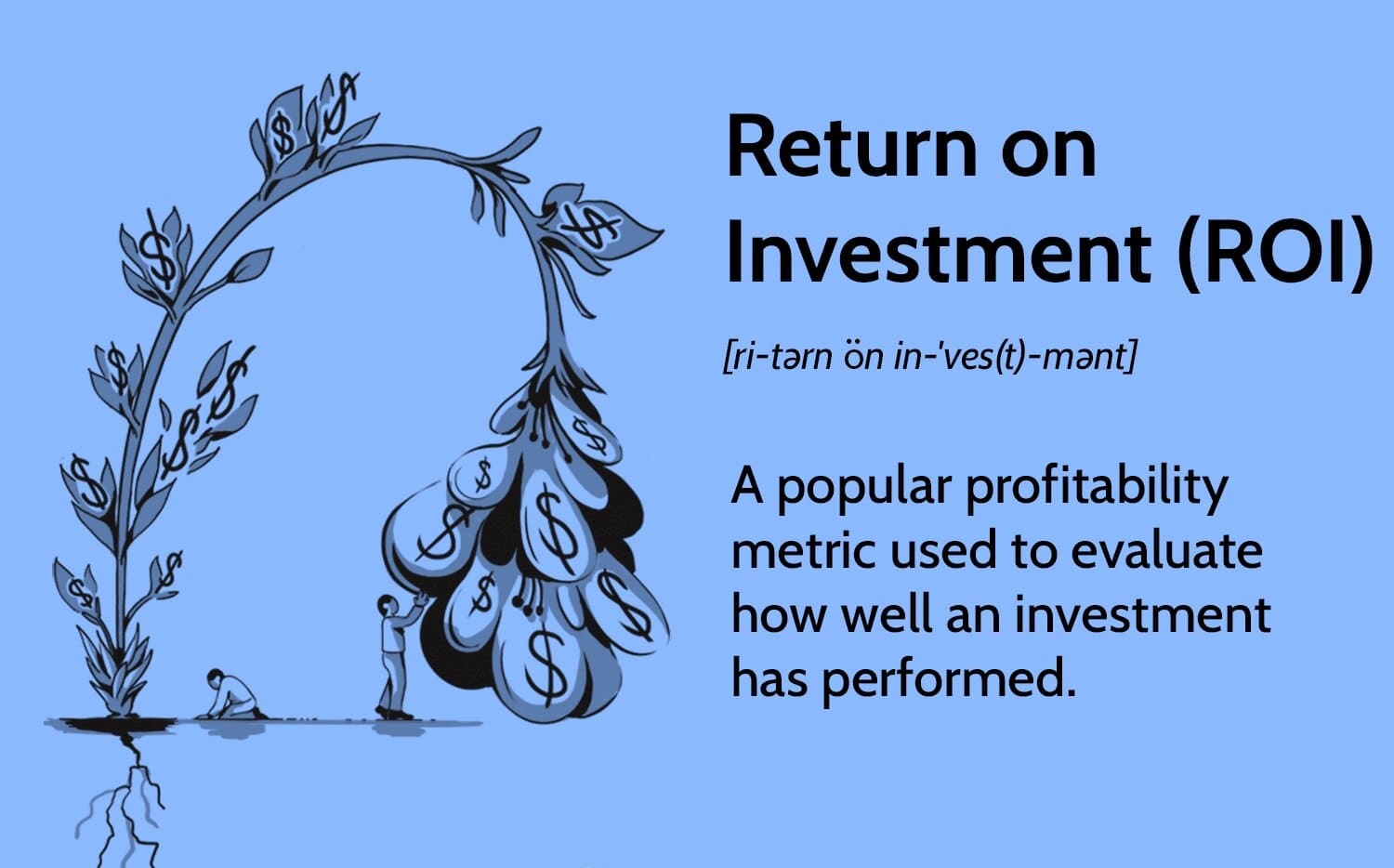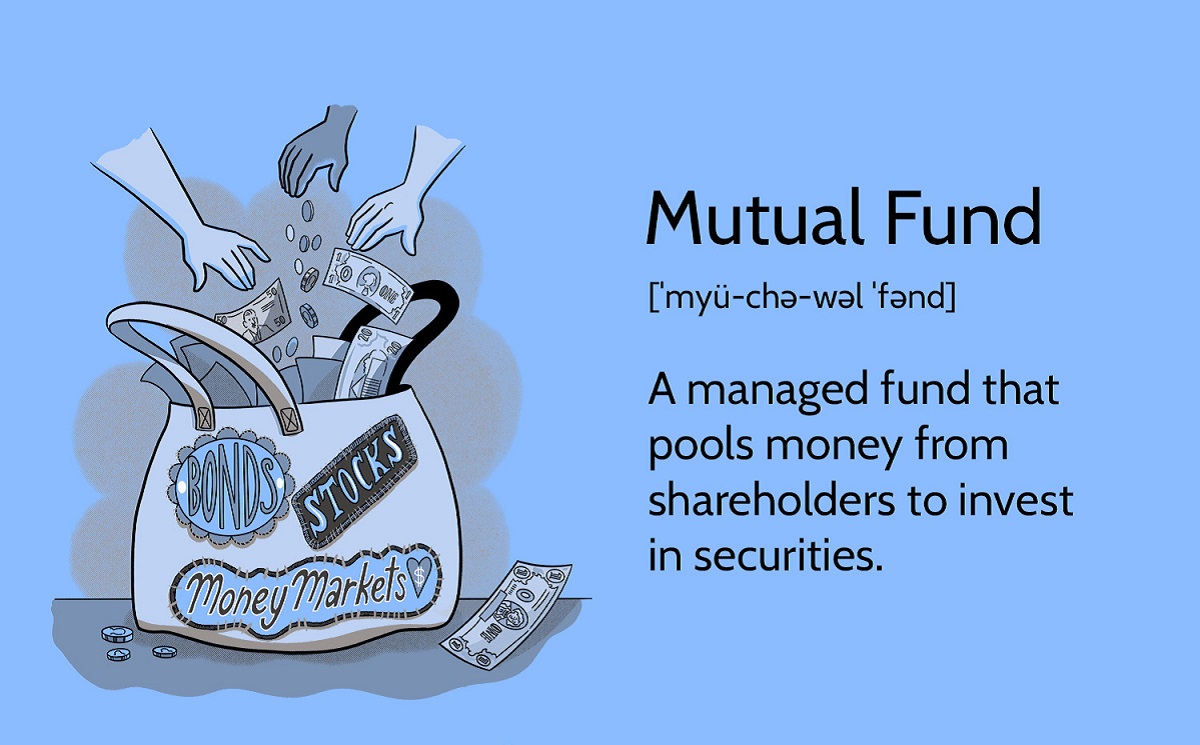Introduction
Investing is a key component of building wealth and securing a financially stable future. It involves allocating resources to various assets with the expectation of generating returns. There are numerous types of investments available, each with its own unique characteristics and potential rewards.
The primary objective of investing is to grow your wealth over time. By putting your money to work, you can potentially earn income, achieve capital appreciation, and mitigate the negative effects of inflation. However, it’s important to note that investing always carries some degree of risk, and the potential for losses is inherent in any investment strategy.
Understanding the different types of investments is crucial for constructing a diversified portfolio that aligns with your financial goals, risk tolerance, and timeline. Diversification involves spreading your investments across different asset classes to minimize risk.
In this article, we will explore several common types of investments, including stocks, bonds, mutual funds, exchange-traded funds (ETFs), real estate, commodities, options and futures, certificates of deposit (CDs), and cryptocurrencies. By gaining insight into these investment vehicles, you’ll be better equipped to make informed decisions and create a well-rounded investment portfolio.
It’s important to note that while this article provides an overview of various investment types, it’s not intended as financial advice. Before making any investment decisions, it’s always advisable to consult with a qualified financial advisor.
Stocks
Stocks, also known as equities, represent ownership in a company. When you purchase shares of a stock, you become a shareholder in that company, giving you a claim on its assets and earnings. Stocks offer the potential for significant long-term returns, but they also come with a higher level of risk compared to other investment options.
One of the key advantages of investing in stocks is the opportunity for capital appreciation. As the company grows and becomes more profitable, the value of its stock can increase, allowing you to sell your shares at a higher price than what you initially paid. Additionally, many stocks also provide dividend payments, which are a portion of the company’s profits distributed to shareholders.
There are different types of stocks, including common stocks and preferred stocks. Common stocks give shareholders voting rights and the potential for capital appreciation, while preferred stocks typically do not come with voting rights but provide a fixed dividend payment.
Investing in individual stocks requires careful research and analysis. It’s important to consider factors such as the company’s financial health, competitive position, industry trends, and management team before making investment decisions. Many investors also choose to diversify their stock holdings by investing in a variety of companies across different sectors, which helps to spread the risk.
For those who prefer a more hands-off approach, another option is investing in mutual funds or exchange-traded funds (ETFs) that hold a diversified portfolio of stocks. These investment vehicles pool money from multiple investors and are managed by professionals, providing instant diversification and simplifying the investment process.
While stocks offer significant growth potential, it’s important to remember that their values can fluctuate widely in response to market conditions, economic factors, and even company-specific news. This volatility makes stocks more suitable for long-term investors who can weather short-term market fluctuations and have a longer-term investment horizon.
Overall, stocks are an essential component of a well-rounded investment portfolio, providing the potential for long-term growth and income. However, it’s crucial to carefully research and monitor your stock holdings to make informed investment decisions and manage risk effectively.
Bonds
Bonds are debt securities issued by governments, municipalities, and corporations to raise capital. When you invest in bonds, you are essentially lending your money to the issuer in exchange for periodic interest payments and the return of the principal amount at maturity. Bonds are often considered lower-risk investments compared to stocks.
One of the primary advantages of investing in bonds is the fixed income they provide. The issuer of the bond agrees to pay the bondholder a predetermined interest rate for a specified period of time. This interest payment, known as the coupon, can be a valuable source of income, especially for conservative investors seeking stable returns. In addition, bonds offer the assurance of the return of the principal amount when the bond matures, making them attractive for capital preservation.
Bonds come in various types, including government bonds, corporate bonds, municipal bonds, and treasury bonds. Government bonds are issued by national governments and are considered among the safest types of bonds, as they are backed by the full faith and credit of the government. Corporate bonds are issued by companies to fund their operations or expansion and carry a higher level of risk compared to government bonds. Municipal bonds are issued by state and local governments to finance public projects such as schools and infrastructure. Treasury bonds are issued by the government and are considered extremely low-risk, as they are backed by the U.S. Treasury.
Bond prices are influenced by changes in interest rates. When interest rates rise, the value of existing bonds generally falls, as investors seek higher-yielding investments. Conversely, when interest rates drop, bond prices tend to rise, leading to capital appreciation for bondholders. This inverse relationship between interest rates and bond prices is an important factor to consider when investing in bonds.
Investors can purchase individual bonds or invest in bond mutual funds or ETFs to gain exposure to a diversified portfolio of bonds. Bond funds are managed by professionals and provide instant diversification across various bond issuers and maturities.
While bonds are generally considered lower-risk investments, they are not entirely devoid of risk. Credit risk, interest rate risk, and inflation risk are some of the factors that can impact bond investments. It’s essential to carefully evaluate the creditworthiness of the bond issuer, monitor changes in interest rates, and consider how inflation can erode the purchasing power of a fixed income stream.
Bonds can be an essential component of an investment portfolio, providing stability, income, and diversification. They are particularly suitable for income-focused investors, risk-averse individuals, or those seeking a more conservative investment strategy.
Mutual Funds
Mutual funds are investment vehicles that pool money from multiple investors to invest in a diversified portfolio of stocks, bonds, or other securities. They are managed by professional fund managers who make investment decisions on behalf of the investors. Mutual funds offer several benefits and are popular among both beginner and experienced investors.
One of the key advantages of investing in mutual funds is instant diversification. By investing in a mutual fund, you gain exposure to a wide range of securities, spreading your investment across different asset classes, industries, and geographic regions. This diversification helps to mitigate risk and reduce the impact of fluctuations in any individual security on your overall investment portfolio.
Mutual funds also offer liquidity, allowing investors to buy or sell their shares on any business day at the net asset value (NAV) price. This provides flexibility and convenience compared to directly investing in individual securities like stocks or bonds. Furthermore, most mutual funds offer automatic investment plans, which allow investors to make regular contributions to the fund and benefit from dollar-cost averaging.
There are various types of mutual funds to suit different investment goals and risk appetites. Equity funds primarily invest in stocks, seeking long-term capital appreciation. Bond funds invest in fixed-income securities such as government and corporate bonds, aiming to generate income and preserve capital. Balanced funds have a mix of stocks and bonds, offering a balanced approach to growth and stability. There are also specialty funds that focus on specific sectors, geographic regions, or investment strategies.
The expenses associated with mutual funds, such as management fees and operating costs, should be carefully considered. These costs can vary among funds and impact your overall returns. It’s crucial to review a mutual fund’s prospectus to understand its fees and expenses before investing.
When choosing a mutual fund, investors should consider factors such as the fund’s performance history, investment philosophy, fund manager’s experience, and risk level. Looking at the fund’s past performance is helpful to evaluate its consistency and track record, but it’s important to remember that past performance does not guarantee future results.
Mutual funds offer a convenient way for individuals to participate in the financial markets without extensively researching and monitoring individual securities. They provide access to professional investment management, diversification, and flexibility. However, investors should regularly review their mutual fund investments to ensure they align with their financial goals and risk tolerance.
Exchange-Traded Funds (ETFs)
Exchange-Traded Funds (ETFs) are investment funds that are listed and traded on stock exchanges, similar to individual stocks. They are designed to track the performance of a specific index, sector, commodity, or asset class. ETFs provide investors with the opportunity to gain exposure to a diversified portfolio of assets, combined with the flexibility of trading them throughout the trading day.
One of the main advantages of ETFs is their diversification. Like mutual funds, ETFs typically hold a basket of underlying securities, such as stocks or bonds. This allows investors to gain exposure to multiple assets within a single investment, helping to spread risk and potentially reduce the impact of volatility on their overall portfolio.
ETFs offer investment options across various asset classes, including equities, fixed-income securities, commodities, and even alternative investments like real estate and cryptocurrencies. They can be used to gain broad market exposure or to target specific sectors, regions, or investment strategies.
One of the distinguishing features of ETFs is their intraday tradability. Unlike mutual funds, which are priced and traded at the end of each trading day, ETFs can be bought and sold throughout the trading day like individual stocks. This provides investors with the ability to react quickly to market movements or implement trading strategies such as stop-loss orders or limit orders.
ETFs are typically passively managed, meaning they aim to replicate the performance of a specific index. These funds seek to match the returns of the underlying index by holding a similar portfolio of securities. Passively managed ETFs often have lower expense ratios compared to actively managed mutual funds.
In recent years, actively managed ETFs have also gained popularity. These funds are actively managed by professional portfolio managers who aim to outperform the market or a specific index. While actively managed ETFs may offer the potential for higher returns, they typically come with higher expense ratios.
It’s important for investors to carefully research and select ETFs that align with their investment objectives, risk tolerance, and time horizon. Factors to consider include the ETF’s expense ratio, tracking error (the deviation between the ETF’s performance and the index it is designed to track), and the liquidity of the ETF (the ease with which it can be bought or sold without significantly impacting the price).
As with any investment, ETFs also come with their own risks. The value of an ETF can fluctuate based on the performance of the underlying assets, market conditions, and other factors. It’s important for investors to understand the specific risks associated with the assets held by the ETF before investing.
Overall, ETFs provide investors with a flexible, diversified, and cost-effective way to gain exposure to various asset classes and investment strategies. Their intraday tradability and potential tax efficiency make them a popular choice for both individual and institutional investors.
Real Estate
Investing in real estate involves purchasing, owning, and managing properties with the goal of generating income and/or capital appreciation. Real estate has long been considered a solid long-term investment option, offering several benefits and unique advantages.
One of the key advantages of real estate investing is the potential for income generation. Rental properties can provide a steady stream of income through monthly rental payments. This income can help cover expenses, such as mortgage payments, property taxes, insurance, and maintenance costs. Additionally, over time, rental income has the potential to increase as rents rise with inflation or through property value appreciation.
In addition to rental income, real estate investments can offer the potential for capital appreciation. Historically, real estate has shown steady long-term growth in value. As demand for properties increases, property prices tend to rise, giving investors the opportunity to sell properties for a profit. However, it’s important to note that real estate values can fluctuate in response to market conditions and economic factors.
Real estate investments also provide diversification benefits. Real estate prices tend to be less correlated with stock market movements, meaning real estate can offer a degree of stability and act as a hedge against stock market volatility. Adding real estate to an investment portfolio can help balance the overall risk and potentially increase returns.
There are various ways to invest in real estate. Direct ownership of properties is one option, where investors purchase residential or commercial properties and manage them independently. This requires time, effort, and expertise in property management. Real estate investment trusts (REITs) are another popular option. REITs are companies that own, operate, or finance income-generating real estate. Investing in REITs allows individuals to access real estate assets without the need for direct property ownership.
Another way to invest in real estate is through real estate crowdfunding platforms. These platforms allow individuals to pool their funds with other investors to finance real estate projects, such as residential developments or commercial properties. This allows investors to access real estate investments with lower capital requirements and diversify their portfolio across multiple properties or projects.
It’s important to note that investing in real estate comes with its own set of risks. Market fluctuations, changes in interest rates, property vacancies, and unexpected maintenance or repair costs are some of the challenges that investors may face. Conducting thorough research, understanding local market conditions, and seeking professional advice can help mitigate these risks.
Real estate can be a valuable asset class for long-term investors seeking income, capital appreciation, and diversification in their investment portfolio. With its potential for stable income, tax advantages, and the opportunity to build wealth over time, real estate remains an attractive investment option for many individuals.
Commodities
Commodities are raw materials or primary agricultural products that can be bought and sold in standardized contracts on commodities exchanges. Investing in commodities provides diversification benefits and allows investors to participate in the global economy by gaining exposure to various industries and natural resources.
One of the main advantages of investing in commodities is their potential to act as a hedge against inflation. As the prices of commodities tend to rise with inflation, owning commodities can help protect the purchasing power of your investment portfolio. Additionally, commodities can offer potential returns through price appreciation driven by changes in supply and demand dynamics.
Commodities can be categorized into several groups, including energy commodities (such as oil and natural gas), precious metals (like gold and silver), industrial metals (including copper and aluminum), agricultural products (such as corn, wheat, and soybeans), and livestock (including cattle and hogs). Each type of commodity is affected by specific factors, such as geopolitical events, weather conditions, global demand, and technological advancements.
Investors can gain exposure to commodities through various means. One option is to directly invest in physical commodities, such as buying gold bars or barrels of oil. However, this approach may come with storage and liquidity challenges. Alternatively, investors can trade commodity futures contracts or invest in commodity exchange-traded funds (ETFs) or mutual funds. These investment vehicles provide access to a diversified basket of commodities without the need for physical ownership or direct trading.
It’s important to note that investing in commodities can be volatile and speculative. Commodity prices can be influenced by various economic, political, and environmental factors, making them subject to fluctuations and higher levels of risk than traditional investments like stocks and bonds.
For individual investors who are new to commodities, investing through ETFs or mutual funds may be a more accessible and diversified option. These funds often have professional management teams who monitor the commodity markets and make investment decisions on behalf of the investors. Investing in commodity funds allows individuals to gain exposure to a diversified portfolio of commodities and potentially reduce individual commodity-specific risks.
Furthermore, investing in commodities should be considered a long-term strategy. Prices can be influenced by short-term market trends, but the long-term performance of commodities is primarily driven by factors such as global economic growth, population demographics, and infrastructure development.
Commodities can play an important role in a well-diversified investment portfolio. By including commodities as part of a diverse range of assets, investors can potentially benefit from the unique characteristics and potential returns offered by these essential resources.
Options and Futures
Options and futures are derivative financial instruments that allow investors to speculate or hedge against future price movements of underlying assets, such as stocks, commodities, or currencies. These instruments offer unique opportunities for investors to profit from market fluctuations or manage risk in their investment portfolios.
Options provide the holder with the right, but not the obligation, to buy (call option) or sell (put option) a specific asset at a predetermined price (strike price) within a specified time frame. Investors use options for various purposes, including speculation, hedging, and income generation through option writing or option selling strategies.
Futures contracts, on the other hand, obligate the buyer to purchase an asset or the seller to sell an asset at a predetermined price on a future date. These contracts are standardized and traded on futures exchanges. Futures contracts are commonly used for hedging against price fluctuations, especially in industries that rely heavily on commodities, such as agriculture or energy.
One of the key advantages of options and futures is the opportunity to leverage capital. Through a small upfront payment known as the premium, investors can control a larger amount of underlying assets. With futures contracts, this leverage is inherent in the contract itself, whereas with options, investors have the choice to exercise or not exercise the contract based on market conditions.
Options and futures can also be used for risk management. Hedging with these instruments allows investors to protect their positions against adverse price movements. For example, a farmer can hedge against the risk of falling crop prices by entering into a futures contract to lock in a certain price for their future harvest.
However, it’s important to note that options and futures carry inherent risks. Time decay, volatility, and the potential for significant losses are some of the factors investors need to consider. It’s crucial to thoroughly understand the mechanics of options and futures, including how strike prices, expiration dates, and pricing models like the Black-Scholes model work, before engaging in trading these derivative instruments.
Options and futures trading requires a good understanding of the underlying assets and the factors that impact their prices. It’s recommended to conduct thorough research, use risk management strategies, and consider consulting with a financial advisor or professional broker who specializes in these types of investments.
Options and futures can be complex and not suitable for all investors. However, for those with a good understanding of the market and risk appetite, these derivatives can provide opportunities for profit and risk management in their investment portfolios.
Certificates of Deposit (CDs)
Certificates of Deposit (CDs) are financial instruments offered by banks and credit unions that provide a safe and secure way to grow your savings. CD accounts typically offer higher interest rates compared to traditional savings accounts, making them an attractive option for individuals looking to earn a fixed return on their investments.
When you open a CD, you deposit a specific amount of money for a predetermined period, known as the term or maturity. The term can range from a few months to several years, and during this time, your money earns interest at a fixed rate. CDs offer various advantages, including guaranteed returns, principal protection, and low risk.
One of the primary advantages of CDs is the certainty of returns. Unlike other investment options, such as stocks or mutual funds, where returns can fluctuate, CDs offer a predetermined interest rate for the entire term of the investment. This predictability makes CDs suitable for individuals who prioritize stability and prefer to avoid market volatility.
CDs are considered low-risk investments because they are insured by the Federal Deposit Insurance Corporation (FDIC) for banks or the National Credit Union Share Insurance Fund (NCUSIF) for credit unions. This means that even if the financial institution fails, your principal investment (up to the legal limit) is protected, providing peace of mind to investors.
CDs also offer flexibility in terms of choosing the length of the term. Short-term CDs, such as those with a maturity of a few months or a year, provide quick access to your funds in case of any unexpected needs. Long-term CDs, on the other hand, often offer higher interest rates, providing the potential for greater returns, but with a longer lock-in period.
While CDs provide security, guaranteed returns, and liquidity options, they do have some limitations. One significant drawback is the lack of liquidity during the term. Withdrawing funds before the maturity date may result in penalties, such as a loss of interest or even a portion of the principal amount. Therefore, it’s important to carefully consider your financial needs and access to emergency funds before committing to a CD.
Additionally, the interest earned on CDs is subject to taxes. Depending on your individual tax situation, you may be required to report and pay taxes on the interest earned. It’s advisable to consult a tax professional to understand the tax implications of CD investments.
CDs can be a valuable addition to your investment portfolio, providing a lower-risk option with stable returns. Whether you’re saving for a short-term goal or looking to preserve and grow your wealth, CDs offer a conservative and predictable investment avenue. It’s essential to compare rates, terms, and fees among different institutions to ensure you select the best CD option for your financial needs.
Cryptocurrencies
Cryptocurrencies have emerged as a new and innovative form of digital or virtual currency. Created using blockchain technology, cryptocurrencies are decentralized systems that allow for secure, peer-to-peer transactions without the need for a central authority or financial institution. As a relatively new asset class, cryptocurrencies offer unique opportunities and challenges for investors.
One of the main advantages of cryptocurrencies is their potential for high returns. Some cryptocurrencies have experienced substantial price appreciation over a short period, attracting investors looking for significant gains. However, it’s important to note that cryptocurrencies are highly volatile, and prices can fluctuate dramatically in a short amount of time.
Cryptocurrencies also offer the potential for increased privacy and security. Transactions made with cryptocurrencies can be anonymous, and the decentralized nature of blockchain technology provides enhanced security against fraud and hacking. Additionally, cryptocurrencies can facilitate cross-border transactions quickly and at a lower cost compared to traditional financial systems.
Investing in cryptocurrencies can be done through various means. The most common method is buying and holding cryptocurrencies, sometimes referred to as “HODLing,” with the expectation of long-term price appreciation. Investors can also trade cryptocurrencies on cryptocurrency exchanges, taking advantage of short-term price movements and volatility.
However, it’s crucial to recognize that investing in cryptocurrencies comes with significant risks. The extreme volatility of the cryptocurrency market can lead to substantial losses if proper risk management strategies are not in place. Regulatory uncertainties, technological vulnerabilities, and market manipulation are some of the factors that can impact cryptocurrency prices.
It’s important for investors to educate themselves about cryptocurrencies and understand the underlying technology before investing. Conducting thorough research, staying updated on market news and trends, and consulting with financial professionals can help navigate the challenges of the cryptocurrency market.
Furthermore, it’s important to diversify your investment portfolio and not allocate a significant portion of your assets solely to cryptocurrencies. Due to their speculative nature, it’s recommended to invest only what you can afford to lose.
Regulations surrounding cryptocurrencies vary from country to country, and it’s crucial to understand the legal and tax implications of investing in cryptocurrencies in your jurisdiction.
The cryptocurrency market is continuously evolving, with new cryptocurrencies and blockchain projects emerging regularly. It’s important to stay informed and adapt your investment strategy as the market landscape evolves.
Cryptocurrencies offer a unique and exciting investment opportunity, but they come with inherent risks. As with any investment, it’s important to assess your risk tolerance, conduct thorough research, and carefully consider your investment goals and timeframe before entering the cryptocurrency market.
Conclusion
Investing in various types of assets is a crucial step towards achieving financial security and building wealth. The different types of investments discussed in this article provide opportunities for income generation, capital appreciation, diversification, and risk management. However, it’s essential to carefully consider your financial goals, risk tolerance, and time horizon before making any investment decisions.
Stocks offer the potential for long-term growth and the opportunity to participate in the success of individual companies. Bonds provide stability, predictable income, and capital preservation. Mutual funds and ETFs offer instant diversification and professional management. Real estate can generate income through rental properties and provide the potential for property value appreciation. Commodities allow investors to gain exposure to global markets and can act as a hedge against inflation. Options and futures offer leverage and risk management strategies. Certificates of Deposit (CDs) provide guaranteed returns and principal protection. Finally, cryptocurrencies present an innovative asset class with the potential for high returns, but they also come with significant volatility and risk.
It’s important to remember that each investment option carries its own set of risks and rewards. No investment is entirely risk-free, and it’s crucial to conduct thorough research, seek professional advice when needed, and regularly review and adjust your investment portfolio to align with your financial goals and risk tolerance.
Furthermore, diversification is key to managing risk effectively. Spreading your investments across different asset classes, industries, and geographic regions helps to reduce vulnerability to any single investment. A diversified portfolio can help cushion the impact of market volatility and potentially enhance returns over the long term.
Lastly, staying informed and adapting to changing market conditions is vital. Economic trends, technological advancements, and regulatory changes can significantly impact the performance of various investments. Continually educating yourself, monitoring market trends, and seeking professional guidance will better position you to make well-informed investment decisions.
Remember, investing is a journey that requires patience, discipline, and a long-term perspective. By understanding the different types of investments and their characteristics, you can make informed decisions to grow your wealth and achieve your financial aspirations.

























